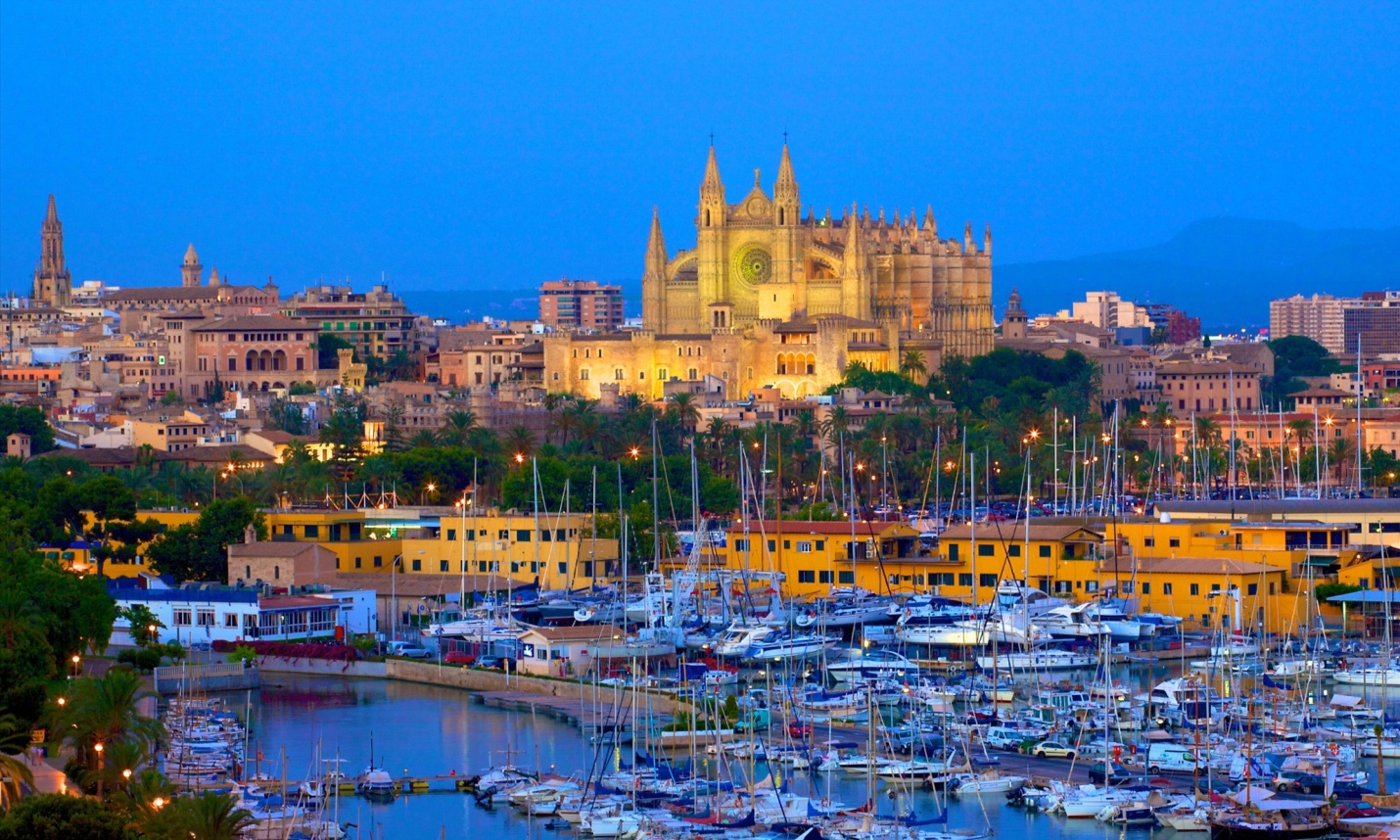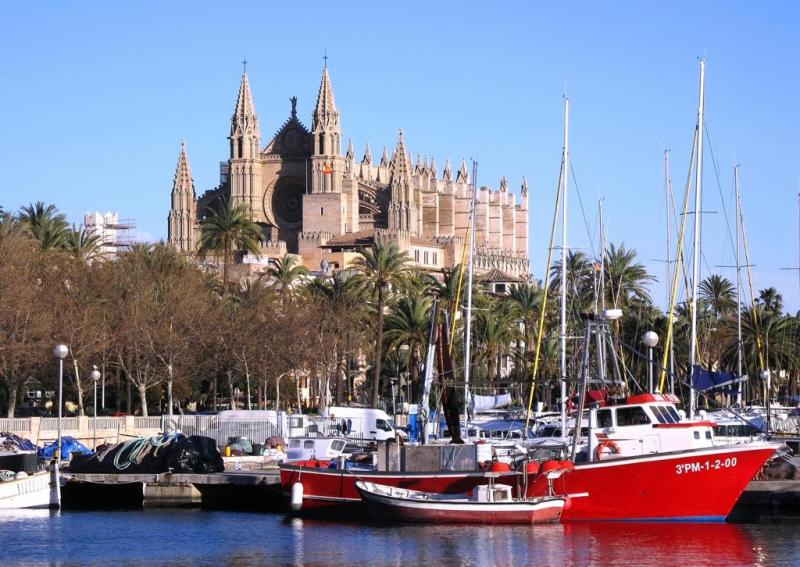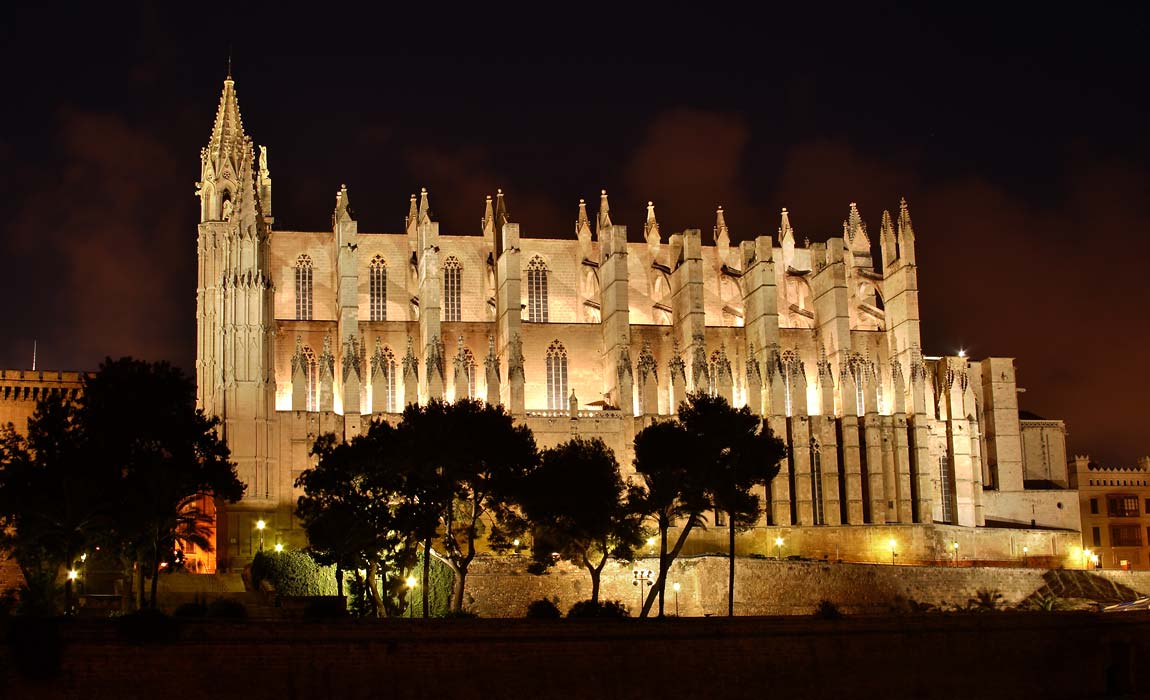
The city of Palma was once coveted by Romans, Moors and Berber pirates. It was King Jaume I who put an end to the Moorish reign in the Mediterranean island (13th century), and who built the most important constructions in Palma. The old quarter of the city stands inside the 18th-century walls which served to repel pirates and corsairs. Visitors will find old churches, palaces and noble mansions with charming courtyards (there are over 40 dotted around the centre of Palma).
The Cathedral of Palma (Sa Seu) is built in a spectacular location on the bay and next to the fishing harbour.  It is an elegant Gothic cathedral, and it is harmoniously built, despite being so large. It was commissioned by King Jaume I, to be built on the site of the old Mayurqa Mosque. The cathedral has very high vaults; although what surprises the most is an impressive rose window and the peculiar wrought iron baldaquin, by the Catalan architect Antonio Gaudí. Opposite Sa Seu is the Almudaina Palace. The former Moorish palace and residence of the monarchs of Majorca is currently used as a museum. Its appearance as a Moorish fortress contrasts with the rich ornamentation of the flamboyant Gothic Chapel of Santa Ana that can be found inside. Situated near the Paseo Sagrera is Sa Llotja. This old fish market, which is used for exhibitions today, is one of the best examples of civil Gothic architecture in Spain. Its Solomonic columns and cross vaults are quite unusual for a secular construction. Together with the Lonja, we find the Consolat (Consulate) de Mar where the regional government has its headquarters, under Renaissance arches.
It is an elegant Gothic cathedral, and it is harmoniously built, despite being so large. It was commissioned by King Jaume I, to be built on the site of the old Mayurqa Mosque. The cathedral has very high vaults; although what surprises the most is an impressive rose window and the peculiar wrought iron baldaquin, by the Catalan architect Antonio Gaudí. Opposite Sa Seu is the Almudaina Palace. The former Moorish palace and residence of the monarchs of Majorca is currently used as a museum. Its appearance as a Moorish fortress contrasts with the rich ornamentation of the flamboyant Gothic Chapel of Santa Ana that can be found inside. Situated near the Paseo Sagrera is Sa Llotja. This old fish market, which is used for exhibitions today, is one of the best examples of civil Gothic architecture in Spain. Its Solomonic columns and cross vaults are quite unusual for a secular construction. Together with the Lonja, we find the Consolat (Consulate) de Mar where the regional government has its headquarters, under Renaissance arches.

Following Paseo Sagrera Avenue you come to the Es Baluard Museum of Modern Art. Its collection comprises works representative of the most significant international tendencies from the end of the 19th century to the present day. Here you can see works by artists such as Cézanne, Gauguin, Picasso, Tàpies, Kiefer and Barceló, amongst others. Other places well worth a visit include the city's museums, such as the Pilar and Joan Miró Foundation or the March Foundation, whose collections feature works by Miró, Dalí and Juan Gris; they also host major temporary exhibitions.
Continue on through Paseo des Born, which is one of the main arteries of the city, dividing the monumental historic quarter from the fishing, popular districts of Sant Joan and Puig de Sant Pere.
If you take Unió street, from the square Plaza Rei Joan Carles, our next stop would be the Caixa Foundation. The old Grand Hotel, a modernist building, now houses an important cultural centre. Across the street, in El Forn des Teatre Bakery, a peculiar Art Deco building, you can try the delicious "ensaimadas" (a flaky, spiral-shaped bun) and the famous "gató" (almond cake), the best of the whole city.
Further down you will find Plaza Mayor, a square with great modernist influence. From this point on, the great avenues and boulevards that make up the new suburbs of Palma de Majorca unfold: the modern city.
To return to the coast from Plaza Mayor, you can go across the historic quarter and visit Plaza de Cort, the City Hall, the Palace of Vivot and the church of Santa Eulària. The City Hall, also known as "Cort", is a Baroque structure built on top of an old sixteenth-century hospital. On the other hand, the church—the first Christian structure erected in Palma— is a great example of the Catalan Gothic period. Other mansions in the area include the neo-Mudejar Can Corbella, Can Forteza Rey and the Modernist building "El Águila".
Another way is to walk through the old Jewish quarter and the district of Sa Calatrava. Along this journey you will see the Gothic temple of Sant Francesc and, at the heart of "Call" (the Jewish quarter), the Baroque church of Montisió, which sits on top of an old synagogue. Reaching the Promenade, you will see the Arab public baths, a reminder of the rule of the Caliphate of Cordoba over these lands.
In this area you can also visit the Museum of Majorca. This ancient palatial-residence houses a magnificent collection that includes prehistoric, Roman, Muslim and medieval artefacts.
Two kilometres away from Palma's city centre is the Castle of Bellver. The castle is located on top of the wooded hill that dominates the bay. Its unusual, circular floor plan and the delicate arches inside lend it an ornamental, rather that defensive, appearance. The precinct is the current home of the Municipal Museum of History.